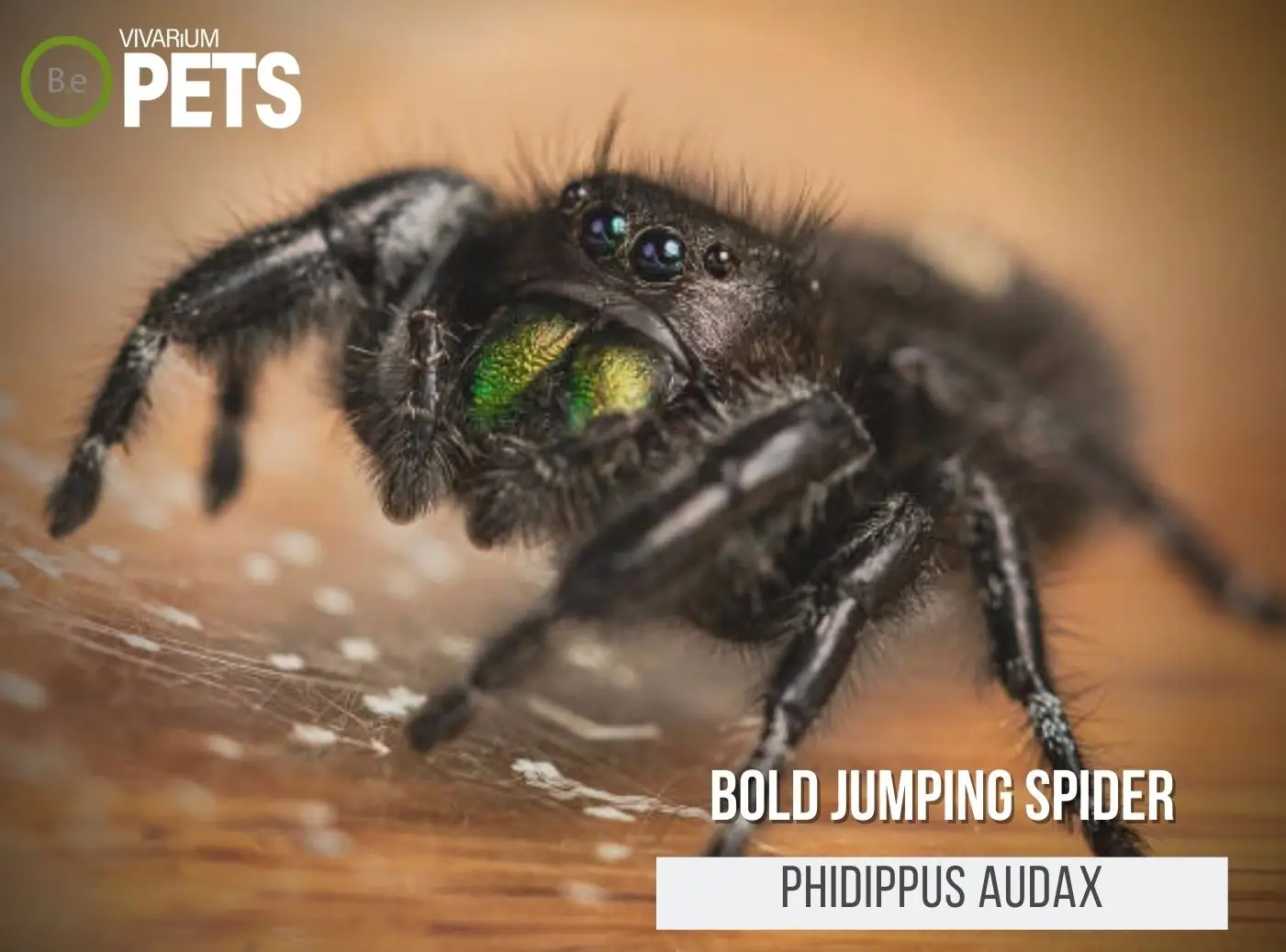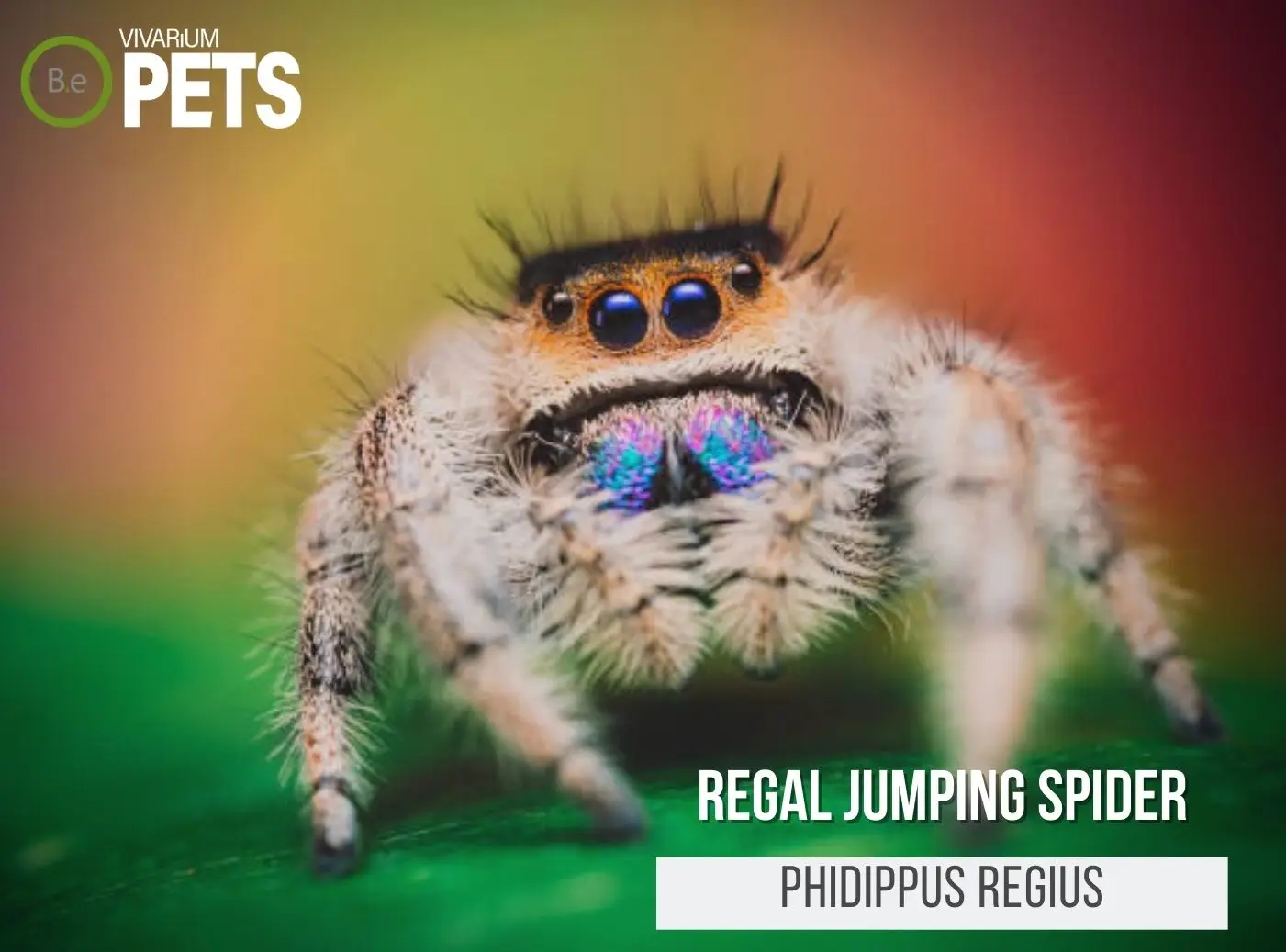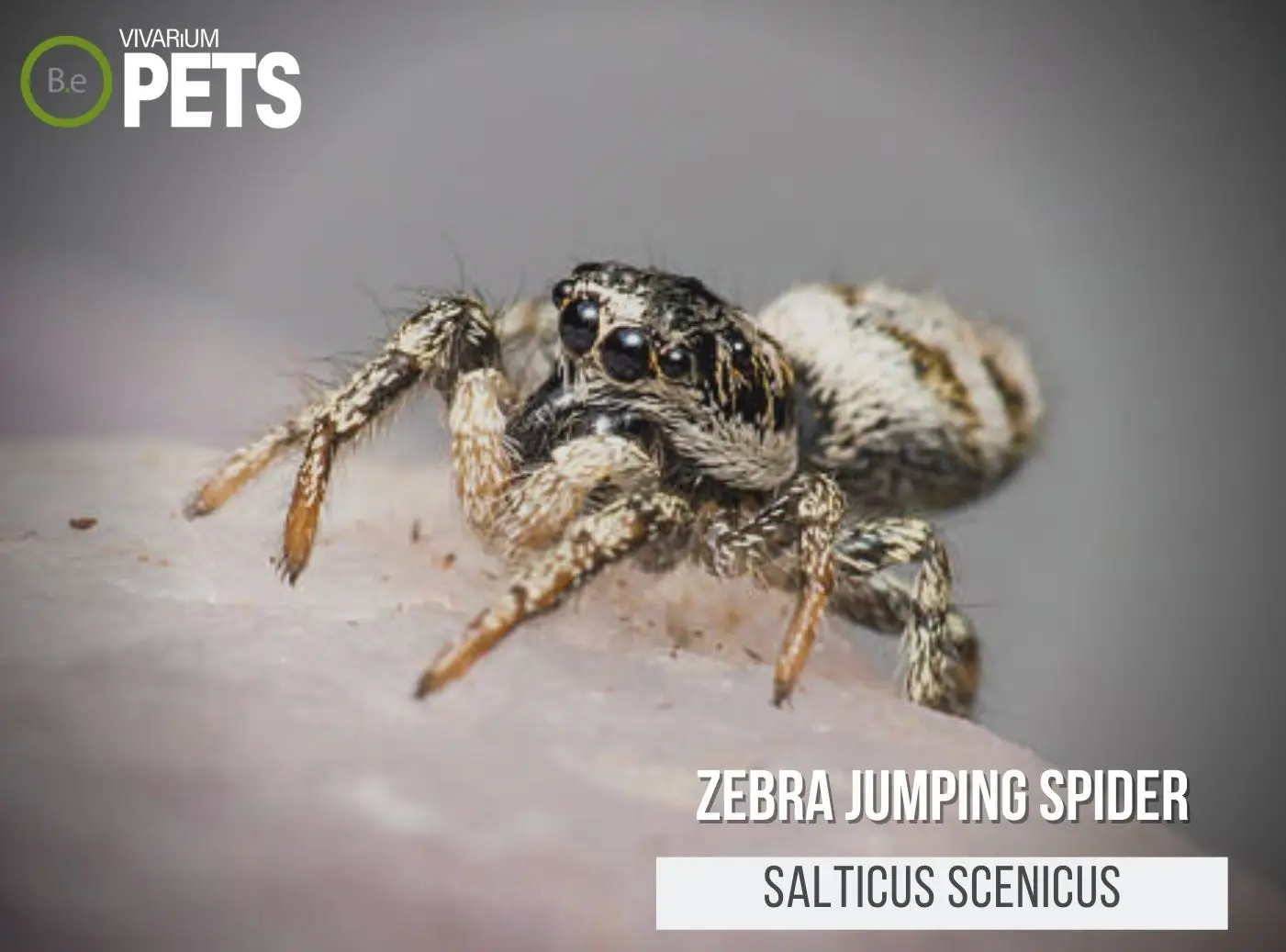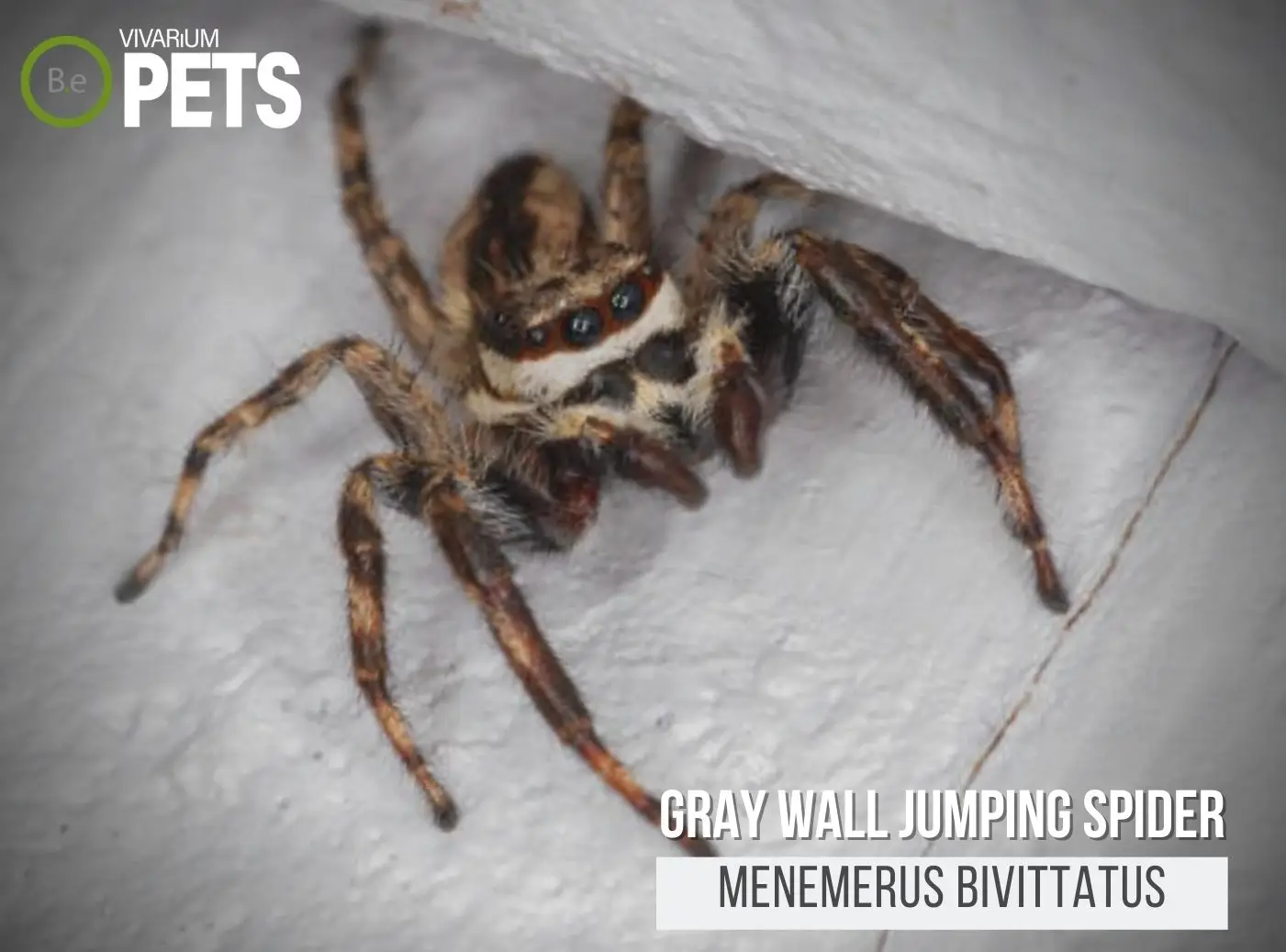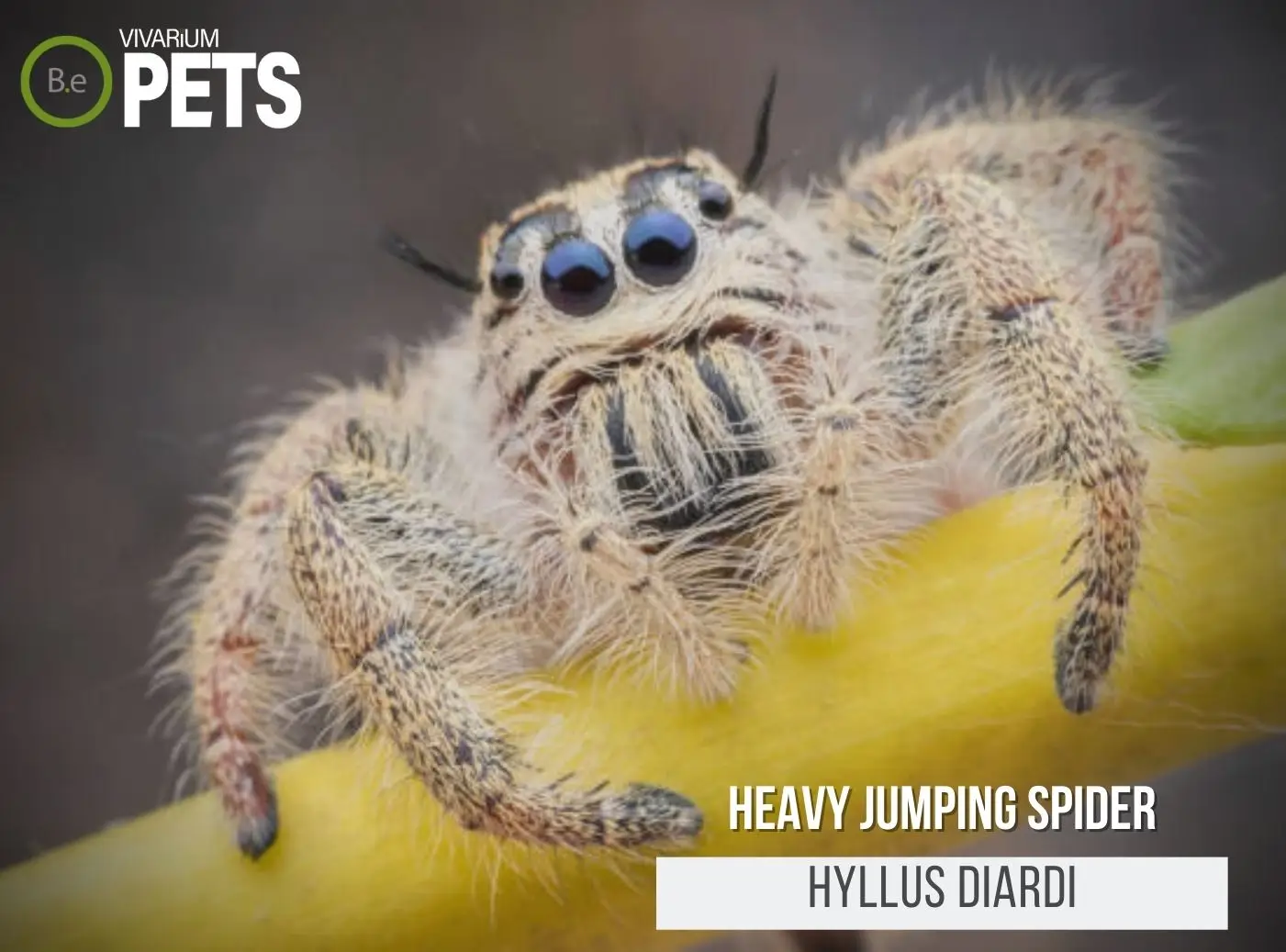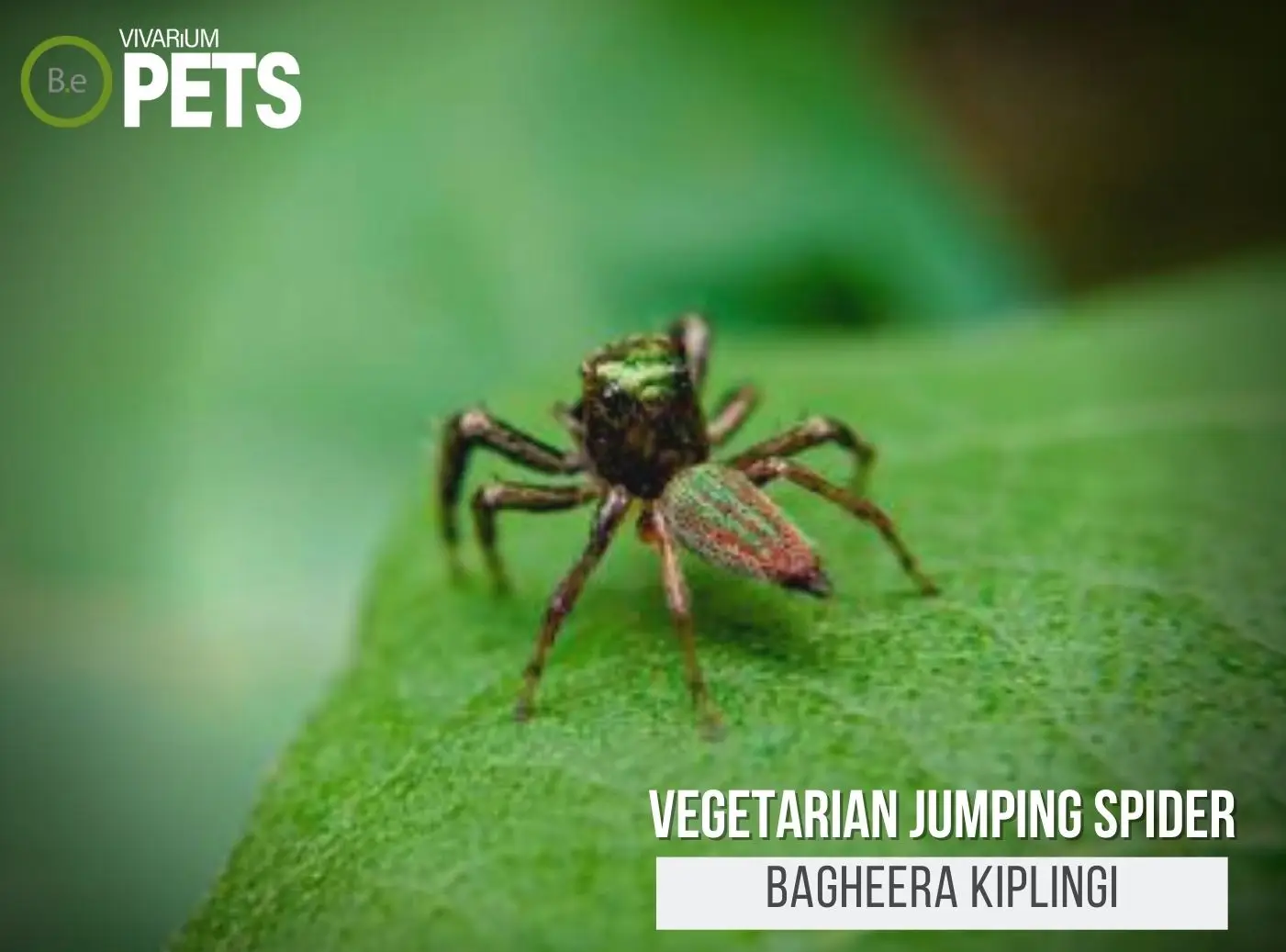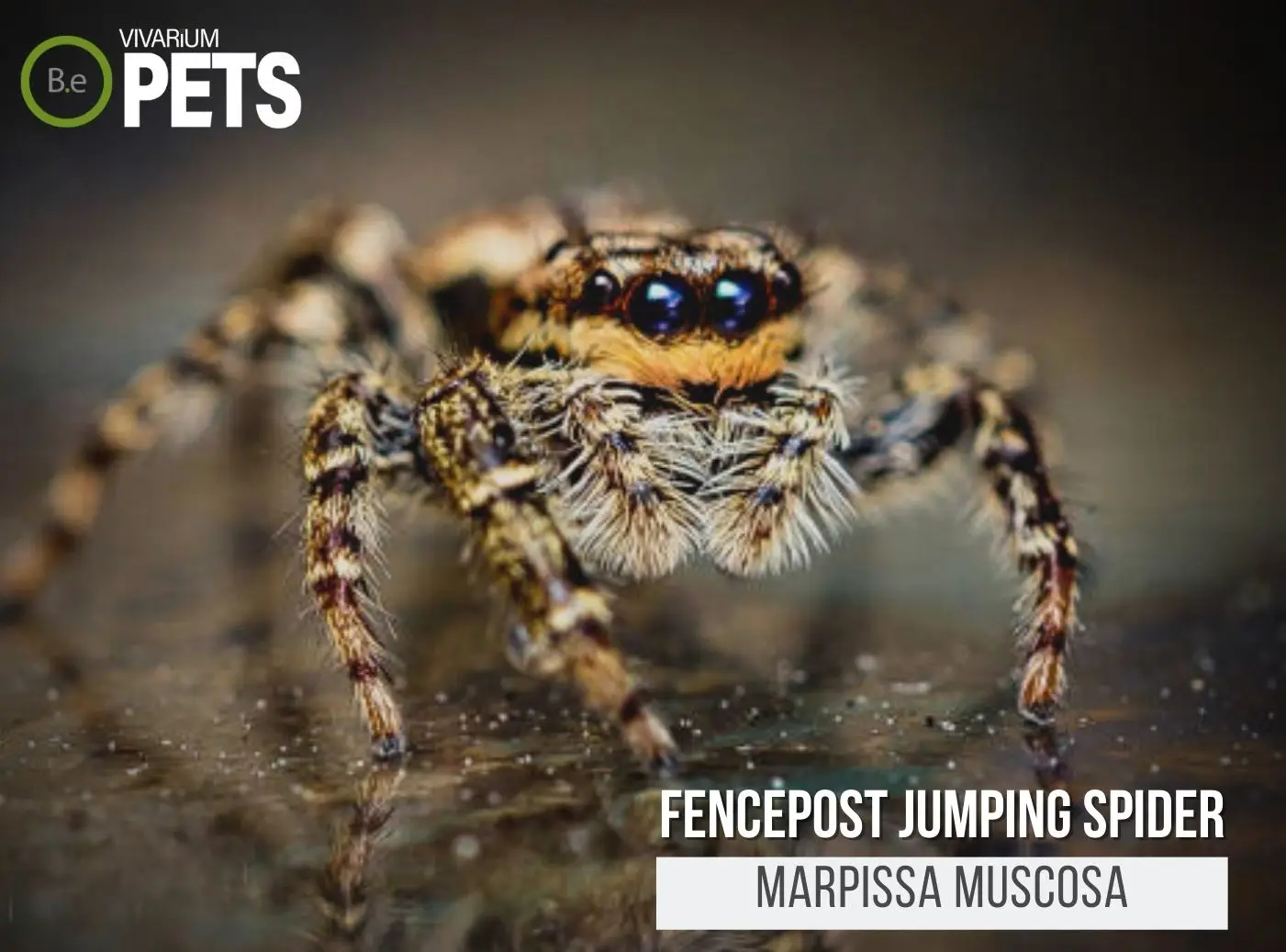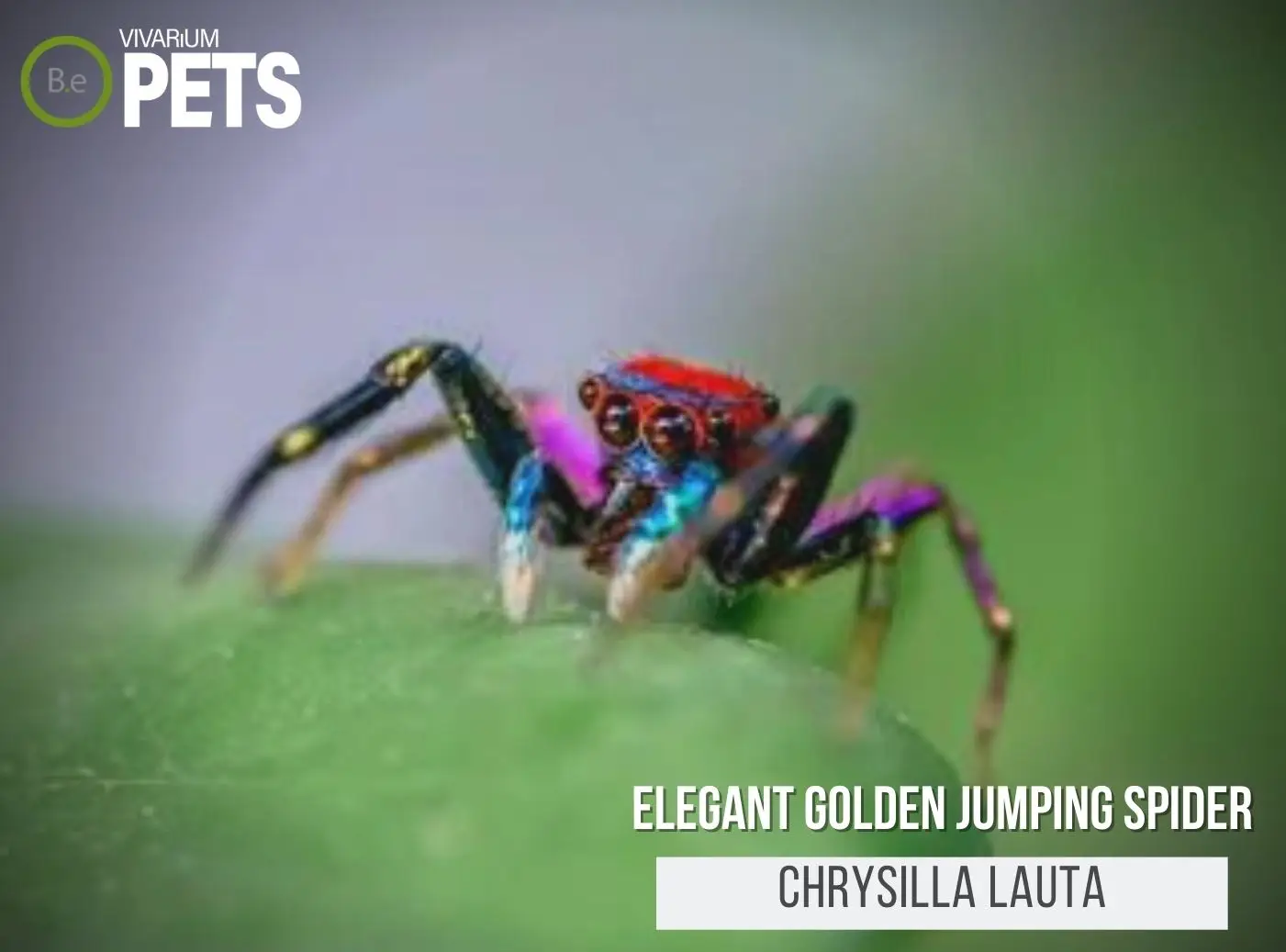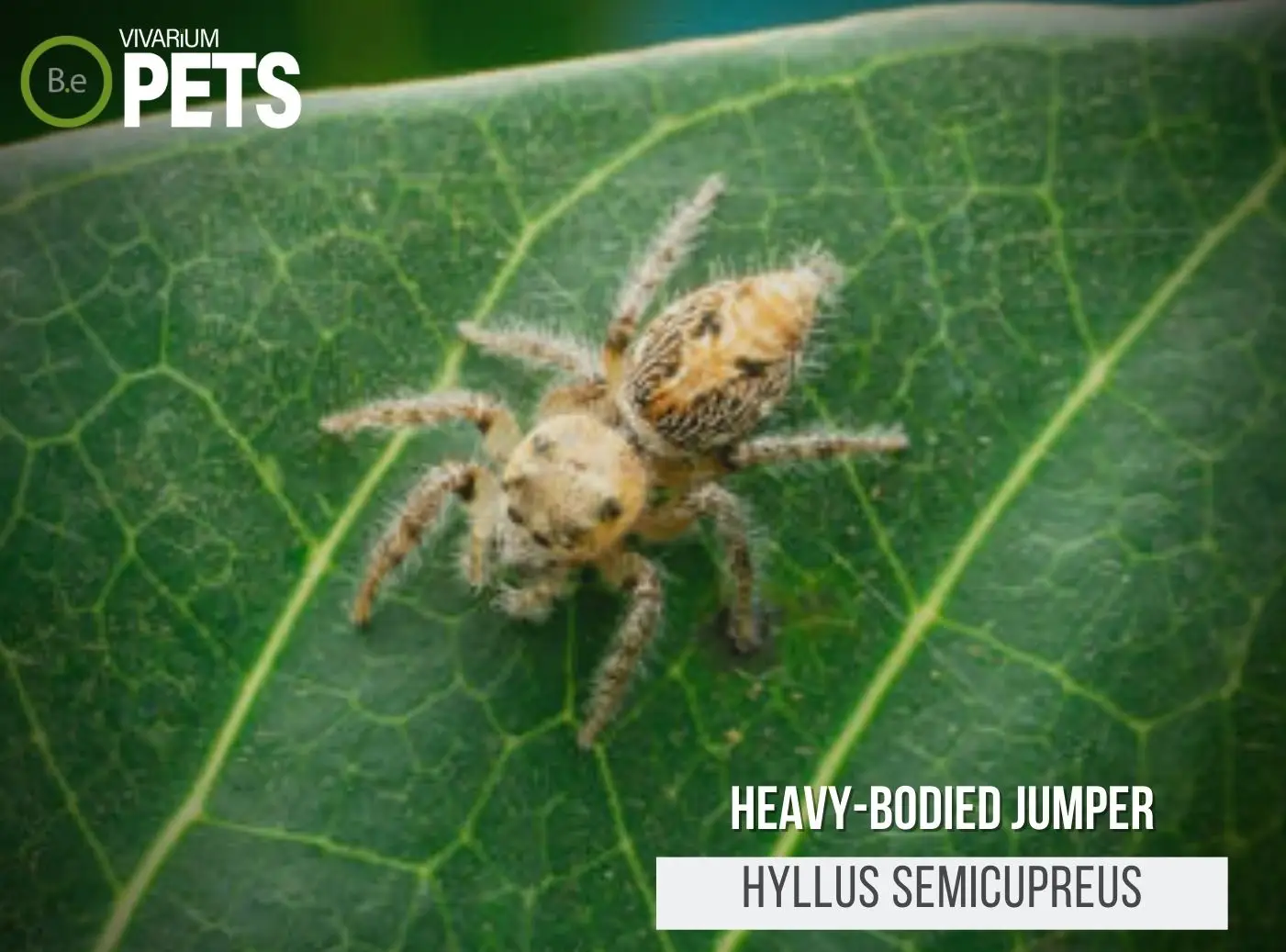Keeping pet jumping spiders in a terrarium is becoming a viral trend across the internet and for good reason.
Not only are they low-maintenance lovable small exotic pets, but they also put on an entertaining show for you each day with their acrobatics.
In this article, we’ll cover the most trendy types of pet jumping spiders suitable for terrariums, how to care for them, and Setting up the perfect terrarium for these micro arachnids.
Table Of Contents:
ToggleWhat Are Jumping Spiders?
Jumping Spiders, also commonly known as Jumpers, are tiny arachnids that belong to the family Salticidae.
This family gets their common name from their habit of moving backward and leaping forward when disturbed or hunting.
Like most spiders, they have eight eyes that help them see in all directions. In fact, jumping spiders have an impressive vision that’s keen to light and movement.
This allows them to easily detect prey and jump on it from a distance. These spiders also come in a variety of sizes, colors, and shapes.
Some types of jumpers even have fangs and venom to paralyze prey!
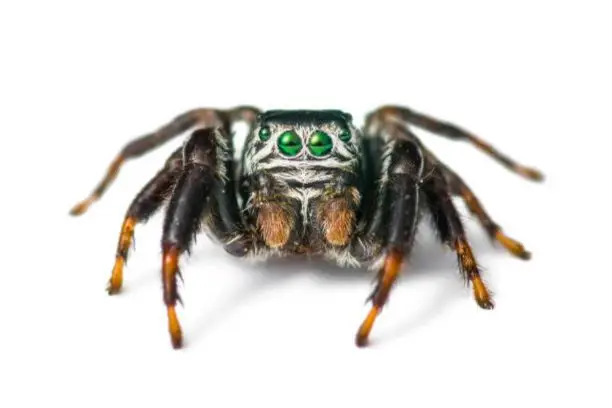

Benefits Of Jumping Spiders
Jumping spiders are beneficial in both their natural habitat as well as terrariums.
In the wild, they feed on small insects and even pest insects, like ants or mosquitoes, helping to keep the environment balanced.
Jumpers also don’t require a lot of space, making them an ideal addition to any ecosystem.
In terrariums, they make great pets to watch and admire.
They don’t need much to be content and are “easy to care for” pets that can spark joy in their own, small way.
Pet jumping spiders can provide a hands–on learning opportunity for children, teaching them responsibility and providing a sense of fantastical wonder.
Best Types Of Pet Jumping Spiders
When choosing the best type of jumping spider for a terrarium, it’s essential to consider the spider’s size, as larger arachnids will require larger terrariums.
Look for jumping spiders that are easy to find, as some types can be difficult to source.
Think about the kind of care they need, as some types may require more specialist food or moisture levels.
Finally, use our helpful guides below to research their natural environment.
Consider the temperament of the type of spider you want – some can be quite skittish while others are calm and don’t mind being handled.
Peacock Spider (Maratus volans)
The Peacock Spider is a colorful and unique jumping spider that will catch anyone‘s eye.
It has multiple vibrant colors such as red, white, blue, and yellow. They are a perfect addition to any terrarium due to their active behavior and lively personality.
These arachnids have the ability to extend numerous stripes of bright color on their abdomen in order to appear larger and more intimidating.
If you want more specifics on this pet jumping spider, here’s a complete care guide on Peacock Spiders (Maratus volans).
Bold Jumping Spider (Phidippus audax)
The Bold Jumping Spider is an alert and spry species of jumping spider, quite unlike the wall–dwelling average creepers.
Named for their lightning–fast reflexes, these spiders have a tendency to startle newcomers with their impressive jumping.
With an iridescent black and white tuxedo pattern, scientists believe that this strong species has evolved to five potential predators in this way.
Ideal for terrariums, these brave and endangered arachnids provide insightful observations even in the comfort of a pet‘s home.
If you want more specifics on this pet jumping spider, here’s a complete care guide on Bold Jumping Spider (Phidippus audax).
Regal Jumping Spider (Phidippus regius)
Regal Jumping Spiders, also known as Phidippus regius, are one of the most commonly kept jumpers out there.
Not only are their colors vibrant, but they have beautiful black bottoms and spots that mesmerize onlookers.
This species makes a great pet jumping spider due to the fact that they are easy to care for and content within their home.
They are also very loving and gentle spiders who enjoy getting snacks and attention.
Although they might take a little bit of time to warm up to your presence, once they do, they will become lifelong friends.
If you want more specifics on this pet jumping spider, here’s a complete care guide on Regal Jumping Spider (Phidippus regius).
Tan Jumping Spider (Platycryptus undatus)
The Tan Jumping Spider is sure to make a known presence in any terrarium!
With its gorgeous tan and black stripes and adorable front–facing eyes, this spider has a unique look that‘s sure to command attention.
It‘s a small–bodied spider with a body size of 8–9 mm. Despite its diminutive size, this species is known for its impressive quickness and agility.
As active hunters, these spiders are always on the hunt for live food they can jump on and catch, making them quite a thrilling pet.
With the proper care and setup, Platycryptus undatus can make for an exciting and rewarding pet.
If you want more specifics on this pet jumping spider, here’s a complete care guide on Tan Jumping Spider (Platycryptus undatus).
Zebra Jumping Spider (Salticus scenicus)
Zebra Jumping Spiders are a species of jumping spiders that are quite popular due to their impressive appearance.
They are characterized by their dramatic black and white stripes, earning them their name.
Salticus scenicus are particularly small and agile and have tremendous eyesight which they use to expertly hunt their prey.
Their relatively tiny size makes them a great choice for a terrarium pet, as their large personalities fit well in a contained space.
Plus, they‘re fascinating to observe as they scamper across the terrarium glass in search of food.
If you’re looking for more specifics on this pet jumping spider, here’s a full care guide on Zebra Jumping Spider (Salticus scenicus).
Pantropical Jumping Spider (Plexippus paykulli)
The Pantropical Jumping Spider is an exceptional pet spider that makes a great inhabitant of any terrarium.
This species is easily recognized for its distinctive color–changing abilities that can range from navy blue, lime green, orange, yellow, and red, depending on the environment and light.
Plexippus paykulli is considered a great pet as it is easy to care for, can adapt to most climates, and is both shy and active.
With its active personality and nocturnal habits, the Pantropical Jumping Spider is a fascinating creature to watch in an enclosure, making it one of the most popular pet jumping spiders for terrariums.
If you’re looking for more specifics on this jumping spider, here’s a full care guide on Pantropical Jumping Spider (Plexippus paykulli).
Gray Wall Jumping Spider (Menemerus bivittatus)
The Gray Wall Jumping Spider is an excellent pet jumping spider candidate for vivariums, with its bright colors and slender appearance.
Also known as the Common House Spider, this species has a distinctive gray zig–zag pattern along its carapace that stands out beautifully against the white chelicerae and legs.
Its active and curious personality makes it an ideal pet for those looking for a more interactive arachnid companion.
With proper care, the Gray Wall Jumping Spider can be the missing piece to your terrarium.
If you’re looking for more specifics on this pet jumping spider, here’s a full care guide on Gray Wall Jumping Spider (Menemerus bivittatus).
Twin-flagged Jumping Spider (Anasaitis canosa)
Twin–flagged Jumping spiders may not be big showstoppers like some other jumping spiders, but they don‘t need to be to make a great pet.
They have an unmistakable two–colored pattern on their bodies, consisting of a creamy yellow and black color scheme.
They‘re hunting skippers, always on the lookout for their next meal.
Anasaitis canosa is a durable little creature, making it perfect for a terrarium setting.
The proper habitat setup and care will make them thrive and allow pet owners to witness their amazing, often comical, behavior up close.
If you’re looking for more specifics on this pet jumping spider, here’s a full care guide on Twin-flagged Jumping Spider (Anasaitis canosa).
Heavy Jumping Spider (Hyllus diardi)
Heavy Jumping Spider is a stunning species of pet jumping spider with vibrant coloring and an impressive leg span.
This species can be found in forests and coastal savannahs of the Indo–Pacific region and is widely kept as a pet in terrariums.
It has a diurnal lifestyle and is typically seen moving around during the day, making it a favorite of many terrarium pet owners.
Unlike other species of jumping spiders, Hyllus diardi can leap to surprisingly high heights when disturbed and therefore can easily be seen jumping around various elements of its enclosure.
With its whopping leg span, the Heavy Jumping Spider is an impressive sight and is a sure standout in any tank.
If you’re looking for more specifics on this pet jumping spider, here’s a full care guide on Heavy Jumping Spider (Hyllus diardi).
Vegetarian Jumping Spider (Bagheera kiplingi)
Vegetarian Jumping spiders are a unique and uncommon species of jumping spiders and can make a jaw-dropping pet for a sealed environment.
This active and fascinating member of the family Salticidae stands out due to its unique diet – it is one of the only known species of arachnid to feed almost entirely on plant matter.
Despite its rather unassuming brown and black coloration, this arachnid is sure to attract attention with its active behavior and entertaining acrobatics.
With proper care and an adequate terrarium setup, these spiders make for a diverse and rewarding pet.
If you’re looking for more specifics on this pet jumping spider, here’s a full care guide on Vegetarian Jumping Spider (Bagheera kiplingi).
Fencepost Jumping Spider (Marpissa muscosa)
Fencepost Jumping Spiders, or Marpissa muscosa, may be small, but they possess an impressive personality with a bold lemon and orange hue splashed across their segmented body.
These energetic spiders often frequent gardens and wooded areas, but can make delightful terrarium housemates.
With their unbridled jumping prowess, these spiders are sure to impress, as they are easily able to launch themselves long distances in any direction, making them a fun and interactive pet.
Not to mention, this species is relatively easy to care for, forming an awesome pet for those just starting out with jumping spiders.
If you’re looking for more specifics on this pet jumping spider, here’s a full care guide on Fencepost Jumping Spider (Marpissa muscosa).
Dimorphic Jumping Spider (Maevia inclemens)
The Dimorphic Jumping Spider can be recognized for its bear-like bottom and harlequin-like pattern on its top, making it an interesting touch to any terrarium.
This species of spider has an innate jumping ability, up to 6 times its body length, that can make it a fun and entertaining pet.
Your furry friend is also quite active and territorial, ensuring that your terrarium will never be dull with a Maevia inclemens around.
With its intelligent behavior and fearlessness, this jumping spider is a great companion for your home.
If you’re looking for more specifics on this pet jumping spider, here’s a full care guide on Dimorphic Jumping Spider (Maevia inclemens).
White-Mustached Jumping Spider (Portia labiata)
The White-Mustached Jumping Spider, or Portia labiata, is an eye-catching arachnid perfect for closed-top terrariums.
These small, hairy spiders are characterized by their short, white ‘mustaches’, and they possess a uniquely intelligent behavior that entices many to keep them as pets.
With a calm demeanor, White-Mustached Jumping Spiders make gentle and docile companions, while their ability to jump up to more than a dozen times their own body length is fun to watch.
With proper care and attention, Portia labiata make great festive pet spiders that can bring an extra dose of wonder to any habitat.
If you’re looking for more specifics on this pet jumping spider, here’s a full care guide on White-Mustached Jumping Spider (Portia labiata).
Two-striped Jumping Spider (Telamonia dimidiata)
Two-striped Jumping Spiders, or Telamonia dimidiata, are a fun and spunky species of jumping spiders that make excellent pets for terrariums.
These active little critters resemble orbital versions of robots, with two thin stripes on a blend of vibrant orange-browns that radiate from their colorful bulbs for eyes.
Not only do these spiders have an incredible personality, but they’re also great jumpers that can impress even the most experienced pet enthusiasts.
They’re active, social, and gentle creatures that are perfect for micro-environments and make great companions for those looking for a unique pet.
If you’re looking for more specifics on this pet jumping spider, here’s a full care guide on Two-striped Jumping Spider (Telamonia dimidiata).
Green Jumping Spider (Mopsus mormon)
Green Jumping Spider is a vibrant-looking jumping spider that is both intriguing and full of personality.
Native to Sri Lanka, these jumping spiders have vibrant lime-green bodies with dark bands on their abdomen and brown legs and antennae.
Its piercing bright eyes and docile demeanor make it extremely popular as a pet jumping spider.
Furthermore, Mopsus Mormon makes for a great terrarium dweller because it is elegant and easily tames.
As long as it is given a warm and dark place, food, and the occasional handling, it will make a great companion.
If you’re looking for more specifics on this pet jumping spider, here’s a full care guide on Green Jumping Spider (Mopsus mormon).
Himalayan Jumping Spider (Euophrys omnisuperstes)
Himalayan Jumping Spiders, or Euophrys omnisuperstes, are a unique and exotic choice for pet jumping spiders that terrarium owners love.
They have a beautiful dark patterned body and orange to yellow stripes down the sides of the abdomen.
Their striking coloration and eyesight even rival that of a hawk!
Himalayan Jumping Spiders are sure to be a standout feature of any tank, especially due to the acrobatic performance they put on when it comes time to catch their insect prey.
If you’re looking for more specifics on this pet jumping spider, here’s a full care guide on the Himalayan Jumping Spider (Euophrys omnisuperstes).
Emerald Jumping Spider (Paraphidippus aurantius)
The Emerald Jumping Spider is a strikingly beautiful species of pet jumping spider.
With distinctive emerald green and yellow markings, these spiders make for a vibrant inclusion in any terrarium.
They are relatively undemanding in terms of care, making them an ideal pet for beginners.
Sitting (or rather, dancing!) atop silvery webs, these spiders are active hunters with exquisite jumping abilities, providing an entertaining and fascinating viewing experience.
What’s more, they can be easily housed together in communities and thrive when kept at moderate temperatures.
All things considered, Paraphidippus aurantius is the perfect pet for those looking for a colorful and fascinating terrarium inhabitant.
If you’re looking for more specifics on this pet jumping spider, here’s a full care guide on Emerald Jumping Spider (Paraphidippus aurantius).
Bearded Foot Spider (Saitis barbipes)
The bearded Foot Spider is a stunning species of jumping spider, endemic to the mountain ranges of Central Europe.
This species of jumping spider can reach up to 5mm in size and features a colorful dark black/brown abdomen marked with several yellow and white stripes.
With its signature long black setae along its legs, Saitis barbipes look more like something out of a tropical rainforest.
Not only does this species of pet jumping spider make for a beautiful terrarium companion, but their active, energetic behavior and curious personality make them endlessly entertaining to watch.
If you’re looking for more specifics on this pet jumping spider, here’s a full care guide on Bearded Foot Spider (Saitis barbipes).
Elegant Golden Jumping Spider (Chrysilla lauta)
The elegant Golden Jumping Spider is one of the most desirable pet jumping spiders for terrariums.
Sporting an athletic physique and brilliant golden/yellow hue, this species sure looks as elegant as its name suggests.
In addition to that, they are also quite hardy, easily adapting to their environments and dealing with environmental changes well.
They make excellent climbers and sprinters, making them interesting spiders to watch and observe.
All in all, Chrysilla lauta makes a perfect pet for any enclosure and an ideal choice for those looking for an active and visually stunning pet spider.
If you’re looking for more specifics on this pet jumping spider, here’s a full care guide on Elegant Golden Jumping Spider (Chrysilla lauta).
Heavy-bodied jumper (Hyllus semicupreus)
The heavy-bodied jumper is an impressive jumping spider that’s sure to be the star of any micro-ecosystem.
It has a distinct black-and-brown pattern along its exoskeleton that is mesmerizing to watch.
To top it off, this remarkable spider has a natural defense system involving a bold display of aggression and raised silk webs.
With patience and proper care, Hyllus semicupreus can be the perfect pet, allowing owners to observe it as it gently moves and forages at home.
If you’re looking for more specifics on this pet jumping spider, here’s a full care guide on Heavy-bodied jumpers (Hyllus semicupreus).
Asiatic Wall Jumping Spider (Attulus fasciger)
The Asiatic Wall Jumping Spider is a species of charming jumping spider that is great for terrariums.
They are easily recognizable by their striking black and white stripes covering the body and legs.
While natively found in Asia, these spiders have quickly become popular as pet jumping spiders due to their unique coloration and up to 1.7 cm leg span.
As they require little throughout their lives, Attulus fasciger make for great pets with their eager personalities and impressive jumping skills.
Watching them hunt is a truly remarkable experience that can provide hours of entertainment.
If you’re looking for more specifics on this pet jumping spider, here’s a full care guide on Asiatic Wall Jumping Spider (Attulus fasciger).
Shiny Jumping Spider (Cosmophasis umbratica)
The Shiny Jumping Spider is a vibrant pet jumping spider that is sure to stand out in a terrarium setting.
Found in parts of Asia, these jumping spiders are marked by their bright metallic coloring.
Though they may appear intimidating because of their sharp colors, they are quite timid and gentle.
Cosmophasis umbratica can be quite the comical creature in your terrarium, as its quick and curious movements often draw attention.
With the proper habitat and meals, they can make a great and unique critter.
If you’re looking for more specifics on this pet jumping spider, here’s a full care guide on Shiny Jumping Spider (Cosmophasis umbratica).
Best Type Of Jumping Spider Terrariums
When selecting a terrarium for your jumping spiders, one of the biggest considerations should be the size.
Your terrarium should be at least ten times bigger than the spider, with plenty of open space to move around.
Make sure the terrarium is outfitted with sturdy lids and locks to prevent escape attempts and potential harm to your pet.
Furthermore, you’ll want to look for terrariums with adequate ventilation and a modest amount of humidity, both of which can help keep your pet jumping spider receiving fresh flowing air.
Best Jumping Spider Substrate
When considering the terrarium substrate for your pet jumping spider’s enclosure, look for a natural type such as cypress mulch, vermicompost, coco fiber soil, peat moss, and leaves.
A substrate mix like this will mimic the natural habitat your pet jumper would find in the wild.
You may also want to add a few hiding places like vivarium wood, small stones, and plants for your pet to explore and keep them busy.
Make sure your substrate is free of pesticides or other chemicals, as these can be harmful to your pet arachnid.
Best Plants For Jumping Spiders
When it comes to terrarium plants, look for plants that are easy to maintain and provide plenty of shelter and hiding spots for jumping spiders.
terrarium moss, mini ferns, and vining plants are all great choices for adding a natural feel to your tank.
Make sure to avoid any plants that could be potentially toxic to your spiders, such as citronella.
Once more, avoid adding too many living plants as this could create high levels of humidity, which can be harmful to some species of jumping spiders.
Proper Pet Jumping Spider Care
Taking care of pet jumping spiders requires more than just food and water.
To ensure optimal health and well-being for your pet spider, you’ll need to provide the right environment and habitat.
Make sure the vivarium is kept out of direct sunlight and kept at an even temperature.
Additionally, mist the enclosure with a spray bottle at least twice a week to create humidity and offer retreats and foraging opportunities for your pet jumpers.
Habitat Requirements
Habitat requirements for pet jumping spiders should include a comfortable substrate for them to climb and explore on, as well as appropriate hiding spots for them to go to when stressed.
Additionally, to provide enrichment for your pet, you’ll want to add branches and tropical plants for your pet to jump between.
Finally, make sure to keep the terrarium uncluttered to provide plenty of space for your jumping spider to move around freely.
Handling
When it comes to handling pet jumping spiders, I recommend going slow and being gentle.
As they can be easily startled, you should always move slowly around your spider and try to avoid sudden movements.
When handling your pet arachnid, you may want to wear gloves to ensure your hands are completely covered and to provide a sense of security for your pet.
Never grab your pet jumping spider, and instead use a moistened cotton swab to scoop them up and move them where you would like them to go.
Feeding & Supplementation
It‘s important to keep your pet jumping spider properly fed.
Most species enjoy small insects such as crickets, locusts, and mealworms. It’s best to feed your pet in the evening when it’s more active.
It’s also recommended that you gut load the insects in order to provide your spider with the essential vitamins and nutrients it needs.
Finally, you’ll want to ensure that you’re feeding the spider the right–sized insects, as feeding it too large of an insect can be dangerous.
If you’re looking for a more detailed approach to feeding these critters, be sure to check out my ultimate DIY jumping spider food guide. I give a more in-depth explanation of the best foods and my favorite recipe.
Identify & Treat Stress
Monitoring your jumpers for signs of illness or stress is important to catch any problems early on. This includes changes in behavior, appetite, or appearance.
If you notice any signs of illness or stress, it’s important to take action right away by adjusting the spider’s environment or diet.
How To Setup A Jumping Spider Habitat
If you're interested in keeping jumping spiders as pets, you'll want to make sure you provide them with the right environment.
Setting up the perfect terrarium for a pet jumping spider is a great way to ensure they're in proper condition.
In this step-by-step guide, I'll show you how to set up a basic habitat for a jumping spider, so it can thrive.
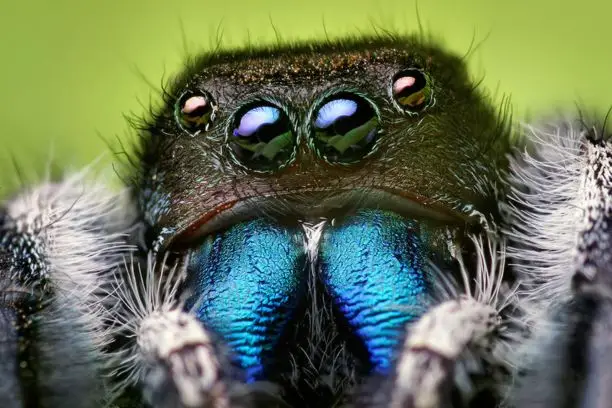

Materials:
Steps to a DIY Jumping Spider Enclosure
Conclusion
Pet jumping spiders are low–maintenance and fun companions that can provide you with hours of enjoyment.
If you are looking for a unique and interesting pet, these spiders are well worth considering. With the right setup and care, jumping spiders are sure to be a welcome addition to any home.
Not to mention, you don‘t have to worry about taking them for walks or giving them baths. So why not open your home to one of these trendy little creatures and enjoy the amazing acrobatics they put on each day?
Frequently Asked Questions
Yes, jumping spiders make good pets due to their intelligence, affection, and social attitude.
Jumping spiders usually live anywhere from 1–3 years as pets with proper care.
Jumping spiders generally do not like or enjoy being petted, as it causes them stress and discomfort.
The best jumping spider to have as a pet would be one that is calm, inquisitive, and easy to care for, such as the Citrus Jumping Spider.
It depends on the spider, but most jumping spiders are not aggressive and unlikely to bite when picked up.
No, jumping spiders are nocturnal and do not require light at night.
You should provide a hiding place, a good substrate, a shallow bowl for water, and a few branches or pieces of cork bark for your jumping spider habitat.
You can identify the gender of a jumping spider by looking for the presence of secondary and primary sexual organs. Males will typically have well–developed palps and long penis–like protrusions whereas females usually have a bulbous and wide epigyne.
Jumping spiders respond the most to movement and changes in their environment, they have excellent eyesight and highly sensitive hair covering their body.
To make a jumping spider terrarium, you will need to provide the proper substrate and climbing materials, and also ensure that it will get enough heat and light for your spider to thrive.
Yes, a jumping spider can live in a jar as long as it is provided with adequate air ventilation and appropriate food and humidity levels.
The ideal enclosure size for jumping spiders should be at least ten times larger than the spider itself to allow for jumping and roaming.
It is recommended to mist your jumping spider‘s terrarium twice a week, making sure that the substrate remains damp and humid.
No, jumping spiders do not need a heat mat as they prefer their habitat to remain on the cooler side.


